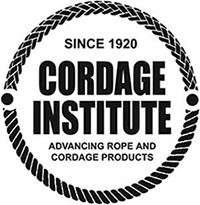 You should be aware that a rope’s rated breaking strength is the optimum strength, achieved under laboratory conditions, in accordance with prescribed test procedures, on new rope, pulling at a slow, steady rate in a straight line. Real life applications normally involve many different types of forces and factors which will cause the rope to fail at much reduced loads. Accordingly, the safe working load of any new rope is much lower than its nominal strength. Blanket safe working load (SWL) recommendations cannot be made for any rope because the SWL must always be calculated based on the application, conditions of use, and potential danger to personnel among other considerations. It is recommended that the end-user establish the SWL base on best practices established by the end user’s industry, professional judgment, and personal experience in combination with a thorough assessment of all risks. In life threatening and other critical applications, the safe working load should not exceed 1/15 of the nominal strength.
You should be aware that a rope’s rated breaking strength is the optimum strength, achieved under laboratory conditions, in accordance with prescribed test procedures, on new rope, pulling at a slow, steady rate in a straight line. Real life applications normally involve many different types of forces and factors which will cause the rope to fail at much reduced loads. Accordingly, the safe working load of any new rope is much lower than its nominal strength. Blanket safe working load (SWL) recommendations cannot be made for any rope because the SWL must always be calculated based on the application, conditions of use, and potential danger to personnel among other considerations. It is recommended that the end-user establish the SWL base on best practices established by the end user’s industry, professional judgment, and personal experience in combination with a thorough assessment of all risks. In life threatening and other critical applications, the safe working load should not exceed 1/15 of the nominal strength.
Knots reduce the strength of ropes by as much as 50% by causing the fibers to become distorted and cut into each other. Many of Cancord’s ropes can be fitted with swaged terminations which are much more efficient than knots, losing only minimal strength.
Ropes should be kept clean. Dirt and grit inside the rope may cause the inner fibers to be cut or abraded, resulting in a loss of strength. Rope should be washed with a mild detergent in luke warm water and rinsed well. Air dry and avoid hot water.
Running ropes over edges such as roof tops or cliff edges causes abrasion to occur rapidly, and causes a cutting action in the rope. Rope must always be carefully protected at these points. Similarly, protection is required if the rope is being wrapped around angle iron or other structures which will cause the rope to suffer abrasion or cutting action. Ropes should be removed from service when deterioration from abrasion becomes excessive. Cancord sells edge protectors designed to minimize abrasion in such situations.
Shock loads such as those experienced in fall arrest, and or other conditions where the load is applied very quickly, cause damage to the rope. Ropes which have been subjected to this type of force must be removed from service, or downgraded to less critical uses.
Nylon ropes will lose about 10% of their strength when wet and will elongate considerably more. They will regain their strength when properly dried.
Ropes will deteriorate from abrasion, excessive heat buildup, exposure to ultraviolet rays from the sun or from fluorescent lights, and exposure to certain chemicals and their fumes. Dirt will embed itself in the rope and cause the fibers to cut or abrade. Ropes should be stored and used, so as to minimize the effect of these and other damaging influences. Ropes should be checked frequently, and before critical use, for signs of deterioration.
Safe use of ropes requires skill, training, and practice. It is the user’s obligation to be qualified to use the ropes & know their limitations. Cancord Inc. guarantees the material and manufacturing of the ropes but accepts no liability for failure due to misuse of any kind, or for use by persons with inadequate training. It is very difficult to judge the safety of used ropes, so it is important to inspect ropes very carefully, and to replace them if there is doubt about their condition.





